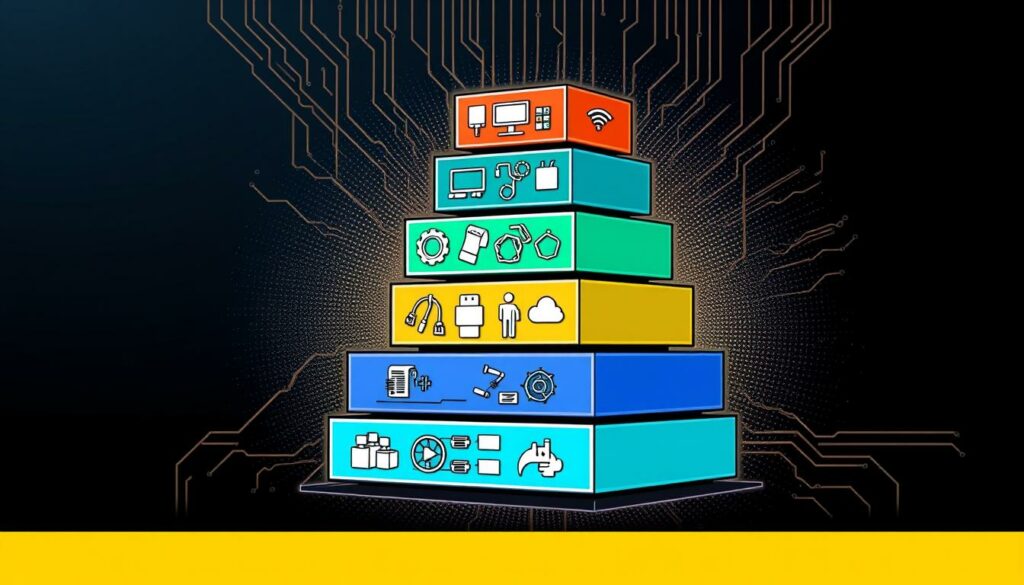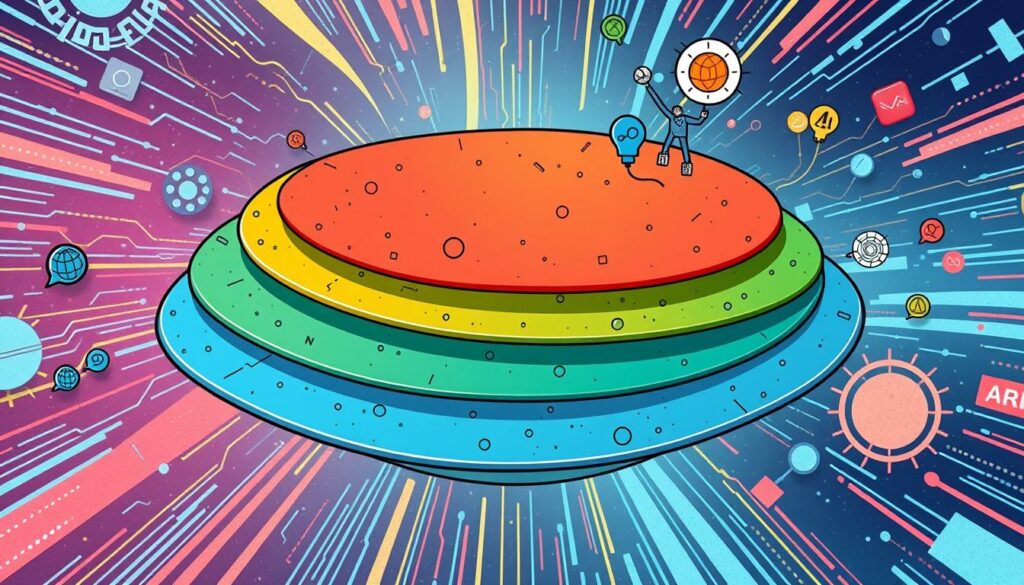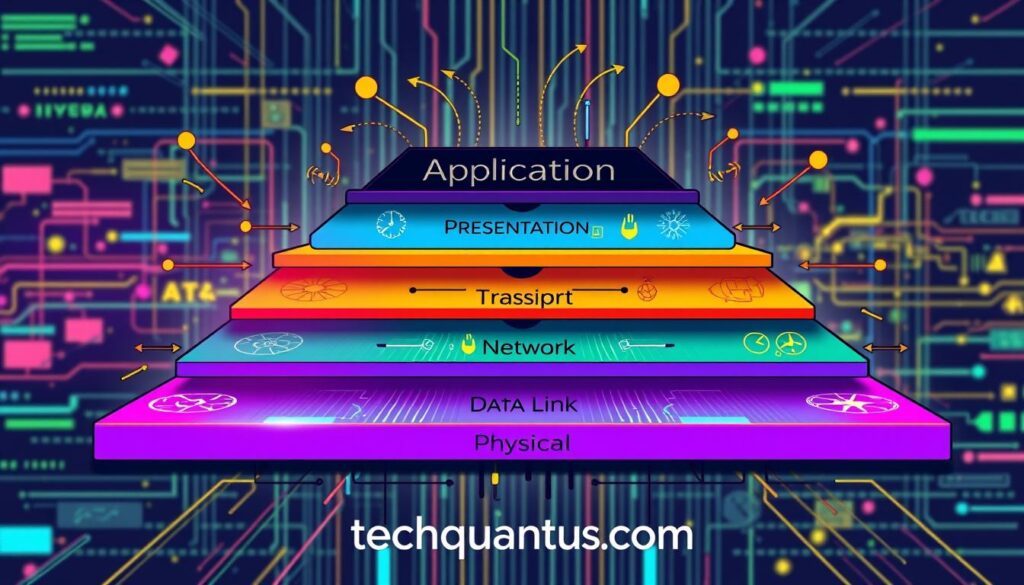The OSI Model helps us understand network communication. It breaks down networking into seven layers. This makes it easier to see how data moves between devices.
In this guide, you’ll learn how each layer ensures devices can talk to each other smoothly. The OSI model is key for IT pros and anyone interested in networking.
Learning the OSI Model is important, not just for school. It’s crucial for fixing network problems, designing networks, and setting them up. As we explore the layers, you’ll see how knowing the OSI Model boosts your IT skills.
This knowledge lets you handle complex networking tasks with ease. For more on related topics, check out this resource.
Key Takeaways
- The OSI model consists of 7 distinct layers that define data communication roles.
- Each layer serves a specific purpose in facilitating interoperability between networked systems.
- Understanding the OSI model is essential for troubleshooting and designing effective networks.
- The OSI model provides a structured approach to studying networking fundamentals.
- Knowledge of the OSI Model can enhance your career opportunities in IT and networking.
Introduction to Networking Fundamentals
Learning about networking basics is key for anyone starting in data communication. You’ll learn about different networks, like LAN and WAN, and their parts like routers and switches. Knowing these basics helps you design and set up networks well.
The OSI model layers are very important in networking. This model helps you understand network complexities. It makes network functions clear, making it easier to talk and solve problems. Knowing the OSI model layers helps you do network tasks better.
Looking into more details about network communications can help you understand how to apply these concepts. For example, learning about network communications can help you make better choices in your networking work. Exploring networking basics gets you ready for real-world challenges in this fast-changing field.
Building a strong networking foundation means knowing how network parts work together. The OSI model layers give you a simple way to see how these parts interact. As you learn more, staying up-to-date with new trends and tech will boost your skills and help you adapt to new ideas.
| Component | Function | Example |
|---|---|---|
| Router | Directs data packets between networks | Connecting a home network to the Internet |
| Switch | Facilitates communication within a local network | Connecting multiple devices in an office |
| Protocols | Set communication rules for network devices | TCP/IP, HTTP, FTP |
What is the OSI Model?
The OSI Model is a key framework in networking. It guides how different protocols work together in communication systems. It breaks down into seven layers, each with its own role in network communications.
Created by the International Organization for Standardization (ISO), it makes sure different devices can talk to each other. Knowing the OSI model helps you build strong networks and fix problems on various platforms and protocols.

The Importance of the OSI Reference Model
The OSI reference model is key for understanding and improving data communication across different systems. It standardizes networking protocols, making communication between various technologies smooth. Without it, integrating systems would be hard and slow.
Knowing the OSI model helps you solve problems better. You can track down issues layer by layer, finding where the problem lies. This method speeds up fixing problems, reducing downtime and boosting productivity.
The OSI model also makes networking easier for professionals. It creates a common language, making training and teamwork simpler. This clear language is crucial in complex networking settings.
Furthermore, the OSI model’s ideas still shape today’s networking. Its concepts are still important, driving progress in data communication. They help keep networks reliable and efficient.
| OS Model Layer | Function | Importance in Data Communication |
|---|---|---|
| Application Layer | User interface and application support | Facilitates user interaction with networked services |
| Transport Layer | Reliable transmission of data segments | Ensures complete data transfer and error control |
| Network Layer | Data routing and forwarding | Manages path determination and logical addressing |
| Data Link Layer | Node-to-node data transfer | Detects and corrects errors in the physical layer |
| Physical Layer | Transmission of raw bit streams | Responsible for physical connections and signal transmission |
Overview of the 7 Layers of the OSI Model
The OSI model layers are the foundation of network communication. They show how network protocols work together. Each layer has a role, helping networks function well. Here’s a quick look at each layer.
Physical Layer
The physical layer is the start of data transmission. It includes hardware like cables and switches. It makes sure data is sent and received right.
Data Link Layer
This layer handles data between devices on the same network. It checks for errors and makes sure data is correct. It’s all about getting data from one device to another without mistakes.
Network Layer
The network layer is about routing data. It uses IP addresses to guide data through networks. Its main job is to find the best path for data to travel.
Transport Layer
The transport layer ensures data is delivered right. It breaks data into pieces and fixes errors. Protocols like TCP and UDP help make sure data is in the right order.
Session Layer
The session layer sets up and ends connections. It keeps communication flowing. It’s all about making sure data is exchanged smoothly.
Presentation Layer
The presentation layer formats data for apps. It also encrypts and compresses data. This adds security and makes data flow better.
Application Layer
The application layer works with user apps. It offers services like email and web browsing. Knowing this layer helps improve network apps.

Functions of Each OSI Model Layer
The OSI model has seven layers, each crucial for network communication. Knowing these OSI layer functions helps you troubleshoot and design networks better.
| Layer | Functions |
|---|---|
| Physical Layer | Transfers raw bitstreams over a physical medium. It defines hardware specs and transmission modes. |
| Data Link Layer | Frames packets for accurate transmission. It ensures error detection and provides physical addressing. |
| Network Layer | Handles data routing between devices and networks. It uses logical addresses like IP. |
| Transport Layer | Manages end-to-end communication. It segments data and ensures reliable packet delivery through TCP and UDP. |
| Session Layer | Establishes, maintains, and terminates sessions between applications. It allows for seamless communication. |
| Presentation Layer | Translates data formats. It manages encryption and decryption, ensuring data is ready for the application layer. |
| Application Layer | Facilitates user interaction. It provides services and protocols for applications like HTTP, SMTP, and FTP. |
The OSI model explained gives insight into how protocols and technologies work together. It shows the importance of each layer for efficient and reliable data communication.
How the OSI Model Enhances Data Communication
The OSI model makes data communication better by giving a clear way to see how protocols work together. Each of the seven layers has its own job, making it easier to understand networking. This helps in designing protocols and fixing problems, leading to better network performance.
The OSI model became a key framework in the early 1980s and was recognized as a global standard in 1984. Big tech companies adopted it, making it a blueprint for data communication. It breaks down communication into layers, helping developers create systems that work across different platforms and technologies.
Here’s a quick overview of how each layer contributes to enhancing data communication:
| Layer | Function | Key Protocols |
|---|---|---|
| Layer 1 (Physical Layer) | Handles network hardware and oversees physical topology | – |
| Layer 2 (Data Link Layer) | Focuses on local frame delivery using MAC Addresses | Ethernet, PPP |
| Layer 3 (Network Layer) | Provides logical addressing and routing services using IP Addresses | IP, ICMP |
| Layer 4 (Transport Layer) | Ensures error-free delivery; supports connection-oriented and connectionless modes | TCP, UDP |
| Layer 5 (Session Layer) | Manages communication sessions between devices | – |
| Layer 6 (Presentation Layer) | Handles data format translation, encryption, and compression | – |
| Layer 7 (Application Layer) | Facilitates end-user applications, such as web browsers and email clients | HTTP, SMTP |
Each layer in the OSI model works on its own, making development easier. This lets experts focus on their areas without affecting the whole system. The OSI model’s structure is key to reliable and effective data communication.
For more details, check out important OSI model topics here. This will help you understand the latest in network architecture.
Real-World Applications of the OSI Model
The OSI model is key in many fields, helping with networking basics and making sure messages get through. In telecom, it helps set up devices like routers and switches for smooth connections.
It’s also vital for fixing network problems. Techs use OSI layers to find and fix issues, from physical problems to protocol mistakes. This makes solving problems faster and easier.
The OSI model is also crucial for new tech development. New tech uses OSI standards for working together, making things more efficient and driving innovation.
In software making, OSI is important too. Developers use it to make sure parts of apps talk to each other well. This makes the development process clearer and more organized.
To show how OSI is used in real life, here’s a table of some tech and OSI layers:
| Technology | Applicable OSI Layer(s) | Description |
|---|---|---|
| HTTP | Application Layer | The foundation for data communication on the Web, enabling client-server interactions. |
| TCP/IP | Transport Layer, Network Layer | Protocol suite ensuring reliable transmission of data packets over the network. |
| VPN | Data Link Layer, Network Layer | Provides a secure network connection over the Internet. |
| Wireless Networks | Physical Layer, Data Link Layer | Connects devices using radio waves, following the OSI model for interoperability. |
| IoT Devices | Multiple Layers | Utilizes various OSI model layers to communicate effectively with other devices and the Internet. |
Knowing how OSI is used helps you understand its role in tech and communication. For more on networking and tech, read this article. The OSI model keeps getting better, shaping the future of networking.
The Future of Network Architecture with the OSI Model
The OSI model is key as networking grows with 5G, cloud computing, and AI. It keeps networks flexible and scalable. This is thanks to its layered approach.
New technologies will use the OSI model’s ideas. This makes it easier to add new protocols and solve problems. It also supports new features like network slicing and virtualization.
As challenges come, developers will update the OSI Model. This keeps it useful for new ideas while keeping core networking values.
Conclusion
The OSI model explained is key to understanding networking. It breaks down the 7 layers of OSI, helping you tackle networking problems. Each layer has its role, making it easier to find and fix communication issues.
As networking tech grows, the OSI model stays vital. It ensures devices and systems can talk to each other smoothly. For IT pros, it’s a must-know for keeping networks running smoothly.
Knowing the OSI model boosts your networking skills. It helps you solve problems and keeps up with new tech. It’s not just for learning; it’s for real-world networking success.
FAQ
What is the OSI Model?
The OSI Model is a framework that breaks down a system into seven layers. It helps us understand how networks and data communicate.
What are the 7 layers of the OSI Model?
The OSI Model has seven layers: Physical, Data Link, Network, Transport, Session, Presentation, and Application. Each layer has its own role in data exchange.
Why is the OSI Reference Model important?
The OSI Reference Model is key for standardizing network protocols. It ensures systems can talk to each other well. It also makes troubleshooting easier by letting us follow the communication path.
How does the OSI Model enhance data communication?
The OSI Model makes data communication better by showing how protocols work together. This leads to efficient and reliable data exchange across different platforms.
Can you explain the functions of each OSI Model layer?
Sure, each OSI layer has a specific job:
– Physical Layer: It sends raw data over a physical medium.
– Data Link Layer: It frames packets and checks for errors.
– Network Layer: It routes data using logical addresses.
– Transport Layer: It ensures data is delivered reliably.
– Session Layer: It manages sessions between apps.
– Presentation Layer: It formats data and handles encryption.
– Application Layer: It offers services to user apps.
What are some real-world applications of the OSI Model?
The OSI Model is used in many areas like telecommunications, cloud computing, and IoT. Network experts use it to set up devices like routers and switches. This ensures they work well together.
How will the OSI Model evolve with future network architecture?
As new tech like 5G, cloud computing, and AI networks come, the OSI Model will still be useful. It guides the creation of new protocols and practices. Its layered structure helps networks grow and adapt.
Source Links
1 . Transmission Modes in Computer Networks (Simplex, Half-Duplex and Full-Duplex) – GeeksforGeeks
2 . Understanding the Application Layer of the OSI Model
3 . Azure AD Connect: Hybrid Identity Management
- Top 5 Web Tools to Enhance Your Online Experience
- The Latest IT News You Can’t Miss Today
- Discover AI Innovations Revolutionizing Computing
- Boost Your Internet Speed: Advanced Techniques
- I Figured Out Why Your Internet is Slow and How to Fix It Fast
Related posts:
 What is ARP? The Address Resolution Protocol Explained
What is ARP? The Address Resolution Protocol Explained
 Quantum Computing for Financial Modeling: What You Need to Know
Quantum Computing for Financial Modeling: What You Need to Know
 Ethical Considerations in the Development of Autonomous Robots
Ethical Considerations in the Development of Autonomous Robots
 How to Use Augmented Reality for Retail Marketing
How to Use Augmented Reality for Retail Marketing
 How to Use AI for Advanced Marketing Analytics
How to Use AI for Advanced Marketing Analytics
 How the Metaverse is Changing the Future of IT
How the Metaverse is Changing the Future of IT
